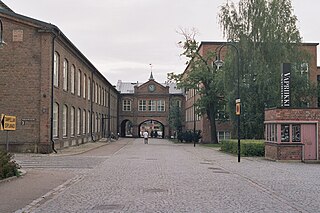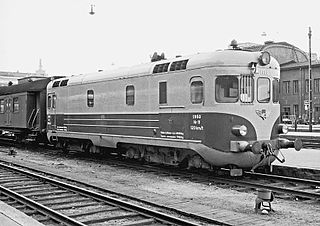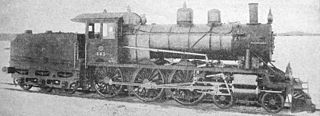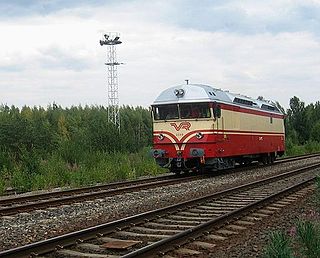
VR-Group Plc, commonly known as VR, is a government-owned railway company in Finland. VR's most important function is the operation of Finland's passenger rail services with 250 long-distance and 800 commuter rail services every day. With 7,500 employees and net sales of €1,251 million in 2017, VR is one of the most significant operators in the Finnish public transport market area.

Under the Whyte notation for the classification of steam locomotives, 0-6-0 represents the wheel arrangement of no leading wheels, six powered and coupled driving wheels on three axles and no trailing wheels. This was the most common wheel arrangement used on both tender and tank locomotives in versions with both inside and outside cylinders.

The Finnish railway network consists of a total track length of 9,216 km (5,727 mi) of railways built with broad 1,524 mm commonly known as Russian gauge track, of which 3,249 km (2,019 mi) of track is electrified. Passenger trains are operated by the state-owned enterprise VR that runs services on 7,225 km (4,489 mi) of track. These services cover all major cities and many rural areas, though the coverage is less than the coverage provided by the bus services. Most passenger train services originate or terminate at Helsinki Central railway station, and a large proportion of the passenger rail network radiates out of Helsinki. VR also operates freight services. Maintenance and construction of the railway network itself is the responsibility of the Finnish Rail Administration, which is a part of the Finnish Transport Agency. The network consists of six areal centres, that manage the use and maintenance of the routes in co-operation. Cargo yards and large stations may have their own signalling systems.

Oy Tampella Ab was a Finnish heavy industry manufacturer, a maker of paper machines, locomotives, military weaponry, as well as wood-based products such as packaging. The company was based mainly in the Naistenlahti district of the city of Tampere.

Oy Lokomo Ab was a Finnish manufacturer of railroad equipment and steam locomotives, situated in Tampere, Finland. The company was founded in 1915 by a group of Finnish businesspeople, including Jalmar Castrén and Emil Aaltonen. The Lokomo factories in Tampere produced the MIR submersibles for the Soviet Academy of Sciences. They later merged into the Metso Corporation. Jaakko Syrjä was a worker for the company.

The Victorian Railways H class was an express passenger steam locomotive operated by the Victorian Railways from 1941 to 1958. Intended to eliminate the use of double heading A2 class locomotives on The Overland services on the steeply graded Western line to Adelaide, wartime restrictions led to only one locomotive being built. Nicknamed Heavy Harry, H220 was the largest locomotive ever built in Australia and the largest non-articulated steam locomotive to run on Australian railways.

Kolari railway station is located in the municipality of Kolari in the Lapland region of Finland. It is the northernmost railway station in Finland, located 800 kilometers north of Helsinki Central railway station.

The Dr16 is a class of diesel-electric locomotives used by VR. The 23 locomotives have a single, off-centre cab and are currently VR's most powerful diesel locomotives. Their nickname is "Iso Vaalee". They are presently mainly used on heavy freight services in northern Finland; their main passenger duty is the haulage of trains on the non-electrified line between Kemi and Kolari in Lapland. Dr16 locomotives were also used extensively on the line between Oulu and Rovaniemi, prior to the completion of the electrification of the line in 2004.

The Dv12 is the standard Finnish medium-weight diesel-hydraulic road switcher operated by VR. As all the main lines of Finnish railway network have been electrificied, the locomotive is designated mostly to unelectrified, less frequently used side lines. Occasionally it may still pull cargo trains on main lines. It has also been put in service as a shunter, replacing older classes Dv15 and Dv16 as they were retired. A total of 192 locomotives were built by Lokomo and Valmet between the years 1963 and 1984. As of 2021, the oldest Dv12 units still in use are 58 years old.

The Jokioinen Railway located in Jokioinen, Finland, was opened for temporary traffic on December 9, 1898. On October 25 1899, the railway began permanent passenger and freight services.

The VR Class Hr11 was the first class of line-haul diesel locomotives used by Valtionrautatiet. Only five units were built, all delivered by Valmet in 1955. The Maybach diesel engines used in the locomotives proved highly unreliable, resulting in a complete overhaul of the engine-transmission system in 1956–58, but this did not solve all of the reliability problems. The Hr11 series was withdrawn from service in 1972.

Hr1 class was the largest passenger express steam locomotive built in Finland. Twenty-two were built between the years 1937–1957. They were numbered 1000–1021.

The Finnish VR Class Tk3 was a 2-8-0 light freight locomotive. It was the most numerous steam locomotive class in Finland with 161 built. 100 locomotives were constructed between 1927 and 1930, with a further 61 ordered and constructed 1943–53. They were numbered 800–899, 1100–1118, and 1129–1170.

VR Class Pr1 was a tank steam locomotive for local passenger services of Finnish railways.

The Finnish Hv1 class was a 4-6-0 express passenger train locomotive. 42 were built between 1915 and 1921. They were numbered 545–578 and 648–655.

The VR Class Vr3 was a class of steam locomotive built in Finland. Before 1942, the class was known as O1. They were nicknamed Kukko and they have the same frames and boiler as the Vr Class Pr1 (Paikku) locomotive. The first locomotive was ordered in 1924 from Hanomag of Germany, number 10 351 and it was numbered 752. The remaining 4 were produced by Tampella Oy in Tampere. They were numbered 752 to 756.

The VR Class Tr1 is a class of heavy freight locomotive built in Finland and Germany. Before 1942 VR Class Tr1s originally had the class name R1. They were nicknamed “Risto”, after the Finnish President Risto Ryti. They were numbered 1030–1096.

VR Class Dr13 was a heavy diesel locomotive used by VR Group. The Dr13 was designed by the French company Alstom. The class consisted of 54 locomotives, of which the first two were built by Alstom’s factory in Belfort, France and were shipped to Finland in 1962, while the rest were built in Tampere at the factories of Lokomo and Valmet. The first Dr13 series locomotive came to Finland on 24 October 1962. The Dr13 series was introduced between 1962–1963, and the last units were withdrawn by June 2000.

The VR Class Vk11 No 101 locomotive was purchased for testing on a six-mile stretch of track between Vuokatti and Sotkamo, where the use of steam locomotives had proved to be uneconomical due to low traffic. The locomotive was ordered from the Swedish act called Ab Slipmaterial of Sweden, and it was completed in 1930. The locomotive had a six-litre Wisconsin petrol-paraffin internal-combustion engine. In January 1931 the locomotive was delivered to Finland, it initially received the number Mt 101. Another very similar locomotive was ordered home in 1935. It was built by Lokomo in Finland and had an 80 hp paraffin Andros petrol-paraffin engine. It initially received the number Mt 102. In 1953 locomotive class designation was changed to Vk11, and in 1962 they were renumbered again to Tve-ko1 and Tve-ko2. Vk11 locomotives were broadly similar to each other, but there were a number of detail differences. Both were two-axle and weighing 12 tons. Both had engines that ran on kerosene / paraffin as fuel but required gasoline / petrol to start them. Locomotives had different lengths of 5.6 m and 6.0 m. Locomotive Vk11 No. 101 was tested on Vuokatti-Sotkamo line for four months. When the passenger rail in this case was discontinued, it was transferred to the locomotive workshop in Oulu on internal traffic. In 1935, the locomotive was placed in a shunting yard in Siuro. After that the locomotive was used at Vaasa and the workshop at Oulu as a shunter. The locomotive was withdrawn in 1962.





















